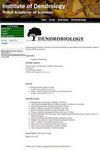Considering both sexual and clonal reproduction could help loosen the conflict of use over Robinia pseudoacacia
IF 1.8
4区 农林科学
Q2 FORESTRY
引用次数: 0
Abstract
Black locust (Robinia pseudocacacia) is a widely planted tree for wood production; however, it is a very problematic invasive species through Europe. At local scale, this tree is able to invades adjacent ecosystems owing to its strong ability of asexual reproduction through root suckers. Due to this phenomenon, the role of sexual reproduction has been quite neglected at local scale. Here, we propose a double approach (i) to evaluate the ability of the species to develop under forest cover using French national forest inventory data (ii) to quantify the role of sexual and asexual reproduction at local scale using a simple visual assessment method. We evidenced that juvenile black locust regenerates in broadleaved forests where R. pseudoacacia did not contribute to the adult canopy; moreover, a significant higher presence in riparian forests relatively to non-riparian ones was demonstrated using national forest inventory data. Regeneration from sexual reproduction mode significantly contributes to local scale invasion (38% of the up-rooted juvenile plants) with a significantly higher ratio of sexual reproduction within oak dominated forests compared to pine dominated ones. We conclude that black locust forestry should consider that both reproduction modes contribute to the species natural regeneration and that both modes can occur under both coniferous and broadleaved forest cover. Thus, we propose to set up safety buffers around sensitive ecosystems such as natural reserves or riparian areas, to maintain black locust cultivation while minimising undesired invasions in natural areas.同时考虑有性繁殖和无性繁殖有助于缓解刺槐的使用冲突
刺槐(Robinia pseudocacacia)是一种广泛种植的木材生产树;然而,在整个欧洲,它是一个非常有问题的入侵物种。在局部范围内,这种树能够入侵邻近的生态系统,因为它通过根吸盘进行无性繁殖的能力很强。由于这种现象,有性生殖的作用在地方尺度上被忽视了。在此,我们提出了一种双重方法(i)利用法国国家森林清查数据来评估该物种在森林覆盖下的发育能力(ii)利用简单的视觉评估方法来量化当地尺度上有性和无性繁殖的作用。结果表明,刺槐幼虫在阔叶林中再生,刺槐对成虫树冠没有贡献;此外,利用国家森林清查数据表明,相对于非河岸森林,河岸森林的存在明显更高。有性繁殖方式的再生显著促进了当地规模的入侵(38%的上生根幼树),在栎树优势林内有性繁殖的比例显著高于松树优势林内。我们认为刺槐林业应考虑两种繁殖模式都有助于物种的自然更新,并且两种模式都可以在针叶林和阔叶林覆盖下发生。因此,我们建议在自然保护区或河岸等敏感生态系统周围建立安全缓冲区,以维持刺槐的种植,同时最大限度地减少对自然区域的不必要入侵。
本文章由计算机程序翻译,如有差异,请以英文原文为准。
求助全文
约1分钟内获得全文
求助全文
来源期刊

Dendrobiology
农林科学-林学
CiteScore
2.20
自引率
11.10%
发文量
17
审稿时长
>12 weeks
期刊介绍:
Dendrobiology publishes original research articles and review articles related to the biology of trees and shrubs.
 求助内容:
求助内容: 应助结果提醒方式:
应助结果提醒方式:


